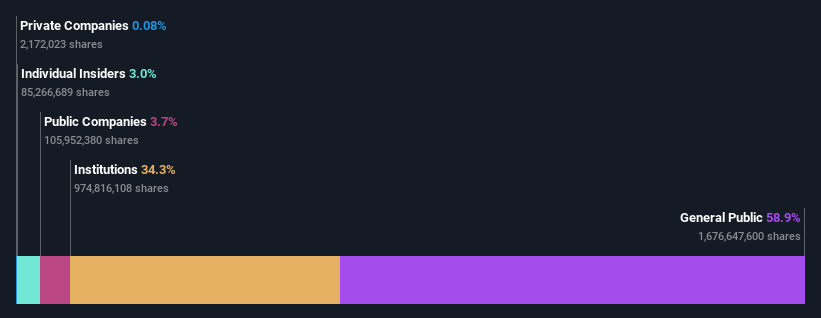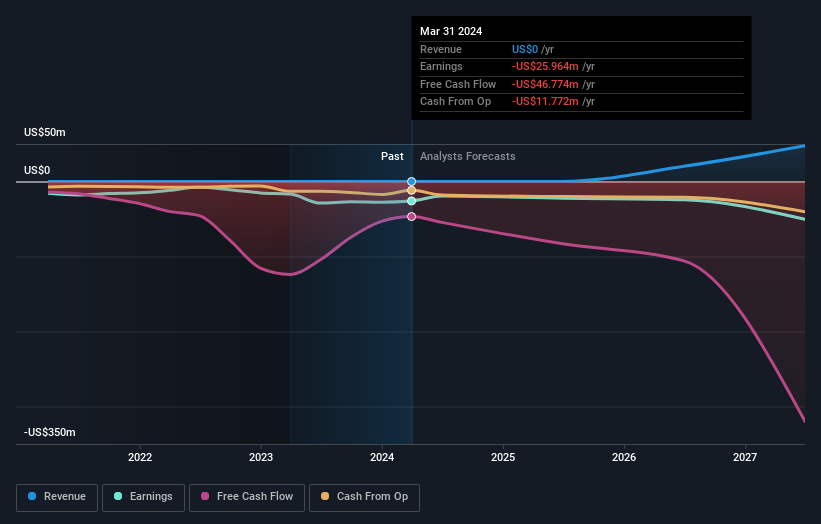- Australia
- /
- Oil and Gas
- /
- ASX:TBN
Tamboran Resources Corporation's (ASX:TBN) 12% loss last week hit both individual investors who own 59% as well as institutions

Key Insights
- The considerable ownership by individual investors in Tamboran Resources indicates that they collectively have a greater say in management and business strategy
- 41% of the business is held by the top 21 shareholders
- Recent purchases by insiders
To get a sense of who is truly in control of Tamboran Resources Corporation (ASX:TBN), it is important to understand the ownership structure of the business. With 59% stake, individual investors possess the maximum shares in the company. Put another way, the group faces the maximum upside potential (or downside risk).
While institutions, who own 34% shares weren’t spared from last week’s AU$57m market cap drop, individual investors as a group suffered the maximum losses
In the chart below, we zoom in on the different ownership groups of Tamboran Resources.
Check out our latest analysis for Tamboran Resources

What Does The Institutional Ownership Tell Us About Tamboran Resources?
Institutional investors commonly compare their own returns to the returns of a commonly followed index. So they generally do consider buying larger companies that are included in the relevant benchmark index.
As you can see, institutional investors have a fair amount of stake in Tamboran Resources. This suggests some credibility amongst professional investors. But we can't rely on that fact alone since institutions make bad investments sometimes, just like everyone does. When multiple institutions own a stock, there's always a risk that they are in a 'crowded trade'. When such a trade goes wrong, multiple parties may compete to sell stock fast. This risk is higher in a company without a history of growth. You can see Tamboran Resources' historic earnings and revenue below, but keep in mind there's always more to the story.

Hedge funds don't have many shares in Tamboran Resources. Teachers Insurance and Annuity Association-College Retirement Equities Fund is currently the company's largest shareholder with 7.6% of shares outstanding. With 7.6% and 4.7% of the shares outstanding respectively, Nuveen, LLC and Morgan Stanley, Investment Banking and Brokerage Investments are the second and third largest shareholders.
A deeper look at our ownership data shows that the top 21 shareholders collectively hold less than half of the register, suggesting a large group of small holders where no single shareholder has a majority.
While it makes sense to study institutional ownership data for a company, it also makes sense to study analyst sentiments to know which way the wind is blowing. There are plenty of analysts covering the stock, so it might be worth seeing what they are forecasting, too.
Insider Ownership Of Tamboran Resources
While the precise definition of an insider can be subjective, almost everyone considers board members to be insiders. The company management answer to the board and the latter should represent the interests of shareholders. Notably, sometimes top-level managers are on the board themselves.
I generally consider insider ownership to be a good thing. However, on some occasions it makes it more difficult for other shareholders to hold the board accountable for decisions.
Our most recent data indicates that insiders own some shares in Tamboran Resources Corporation. In their own names, insiders own AU$13m worth of stock in the AU$427m company. Some would say this shows alignment of interests between shareholders and the board. But it might be worth checking if those insiders have been selling.
General Public Ownership
The general public, mostly comprising of individual investors, collectively holds 59% of Tamboran Resources shares. This level of ownership gives investors from the wider public some power to sway key policy decisions such as board composition, executive compensation, and the dividend payout ratio.
Public Company Ownership
It appears to us that public companies own 3.7% of Tamboran Resources. It's hard to say for sure but this suggests they have entwined business interests. This might be a strategic stake, so it's worth watching this space for changes in ownership.
Next Steps:
While it is well worth considering the different groups that own a company, there are other factors that are even more important. Be aware that Tamboran Resources is showing 3 warning signs in our investment analysis , and 2 of those can't be ignored...
Ultimately the future is most important. You can access this free report on analyst forecasts for the company.
NB: Figures in this article are calculated using data from the last twelve months, which refer to the 12-month period ending on the last date of the month the financial statement is dated. This may not be consistent with full year annual report figures.
Valuation is complex, but we're here to simplify it.
Discover if Tamboran Resources might be undervalued or overvalued with our detailed analysis, featuring fair value estimates, potential risks, dividends, insider trades, and its financial condition.
Access Free AnalysisHave feedback on this article? Concerned about the content? Get in touch with us directly. Alternatively, email editorial-team (at) simplywallst.com.
This article by Simply Wall St is general in nature. We provide commentary based on historical data and analyst forecasts only using an unbiased methodology and our articles are not intended to be financial advice. It does not constitute a recommendation to buy or sell any stock, and does not take account of your objectives, or your financial situation. We aim to bring you long-term focused analysis driven by fundamental data. Note that our analysis may not factor in the latest price-sensitive company announcements or qualitative material. Simply Wall St has no position in any stocks mentioned.
About ASX:TBN
Tamboran Resources
A natural gas company, focuses on developing unconventional gas resources in the northern territory of Australia.
Adequate balance sheet slight.


